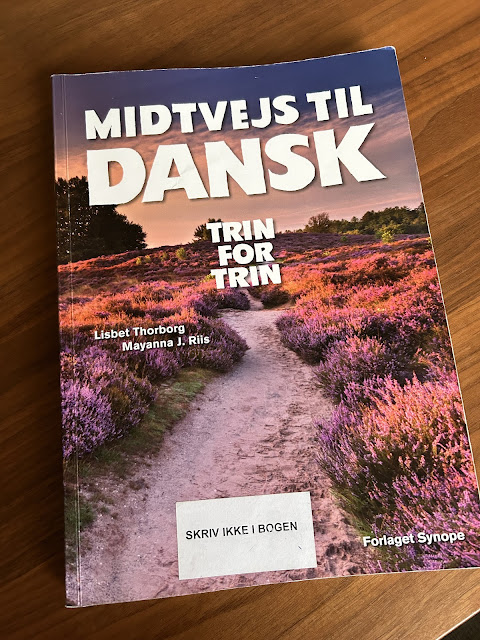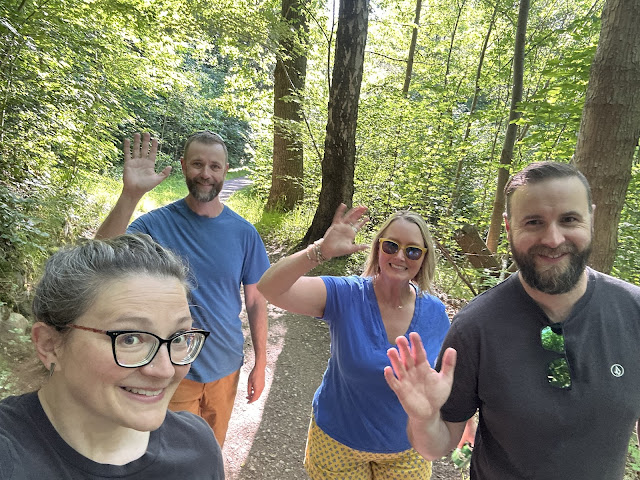More on the Language
I don't know if anyone is still interested in our Danish language journey, but I try to keep track of some of the interesting things we learn as we continue studying, and when I think I have enough things saved up, I throw them in a post. :)
* * *
First, we've learned that Danes don’t capitalize some of the proper nouns (e.g. days of the week, months, nationalities, languages).
In English, we would write: "I will speak Danish in October."
In Danish, we write: "Jeg skal tale dansk i oktober."
I think it's kind of tough to figure out what to capitalize and what not to capitalize, but I'm sure I had that problem in second grade or something, too, so we'll figure it out.
* * *
We've also learned that there are plenty of words that are similar to their English counterparts (and some that are directly from the English word).
For example: for (for), efter (after), navn (name), ord (word), høre (hear), øre (ear), bager (baker), bus (bus), glas (glass), kop (cup), kaffe (coffee), også (also), pizza (pizza), job (job), etc.
 |
| Te = tea, vanilje = vanilla, tehus = tea house...see? Sometimes, it's easy to read. |
We are at the stage in our learning where we sometimes try to read full paragraphs or short passages in their entirety, even if we don't know what some of the words mean. Having words pop up every now and then that are similar to a word in English, along with the context of the passage and words we DO know, helps us connect the dots and understand. It's kind of fun.
* * *
Unfortunately, many Danes still can't understand us half the time when we attempt to speak Danish. In the melting pot that is the United States, Americans are used to hearing English spoken with all kinds of different accents. We hear people from all over the world speaking English as a second language because English is the language of global business and many other countries teach it to their children in addition to their mother tongue.
Danes are not as used to hearing people speak Danish as a second language. Many people don't bother to learn it when they come here since you can get by without it. As someone who appreciates languages, I can understand the difficulty, and while it's a little discouraging to try but not be understood, I get an extra boost of joy when someone understands me and follows it up by complimenting min udtale (my pronunciation)!
* * *
In language-adjacent news:
I've been exploring Danish crossword puzzles, and they're different than crosswords in the U.S.!
You're all familiar with the standard U.S. crossword puzzle format: You are given a series of numbered clues that either correspond to an answer that goes across or down. You fill in the answers, and the letters down and across help to form other answers. There is usually a three-letter minimum for answers, there can be a little secret puzzle to fill out within the puzzle, the answers can be a play on words, etc.
In Danish crosswords, the clues are written directly into the puzzle, and the down and across clues are in the same box! Sometimes, the clues are pictures.
I assumed picture clues were only in children's puzzles, but they are in the more advanced ones, too, because I see them in the paper each week.
Obviously, the clues are challenging because not only do I have to know how to translate the Danish clue, I then need to figure out a synonym (in Danish). On rare occasions, I can do this on my own, especially in children's crosswords. Sometimes, I can figure out what the clue means and I know what the answer should be, but I don't know the Danish word for the answer, so I look it up. I think at this stage in my learning, that still counts as a win.
I still haven't finished one though...
* * *
OK, and for now, the last thing I'll mention is that the Danes, even though they already have three more vowels than we have in English (ø, æ, and å), use the letter Y as a vowel way more consistently than we do in the U.S.
As an English-speaking person, it's very strange for me to see words that are more than three letters long in which Y is the only vowel, let alone words where it is used twice as the vowel!
When our instructor wrote the Danish word for "humble" on the whiteboard, Zac and I just laughed. It seemed totally unpronounceable, like Anders was playing a joke on us or something. It was like when a toddler gets your cell phone and accidentally texts someone an indecipherable message. It was like a cat walked across the keyboard.
I give you: ydmyg.
It's pronounced kind of like "Eeewle-myewh". Give it a try. Haha.
* * *
I guess that's all I have for now. We are starting to try to read books with simple language (shout-out to my colleague who brought in a box of old Danish children's books to give away) and to read longer paragraphs without getting hung up when we stumble on a word we don't know.
We can also pick out more and more words during Danish training sessions and lunch chats and at least follow the topics for the most part. It still feels slow, but I'm having a great time learning it, and Zac is tolerating it. (I think he'd like it more if he didn't have to learn late in the evening on work nights.)
I hope you think some of the language stuff is interesting. We sure think so, even if we aren't that good at it yet. Stay ygmyg, everyone. :)









Comments
Post a Comment